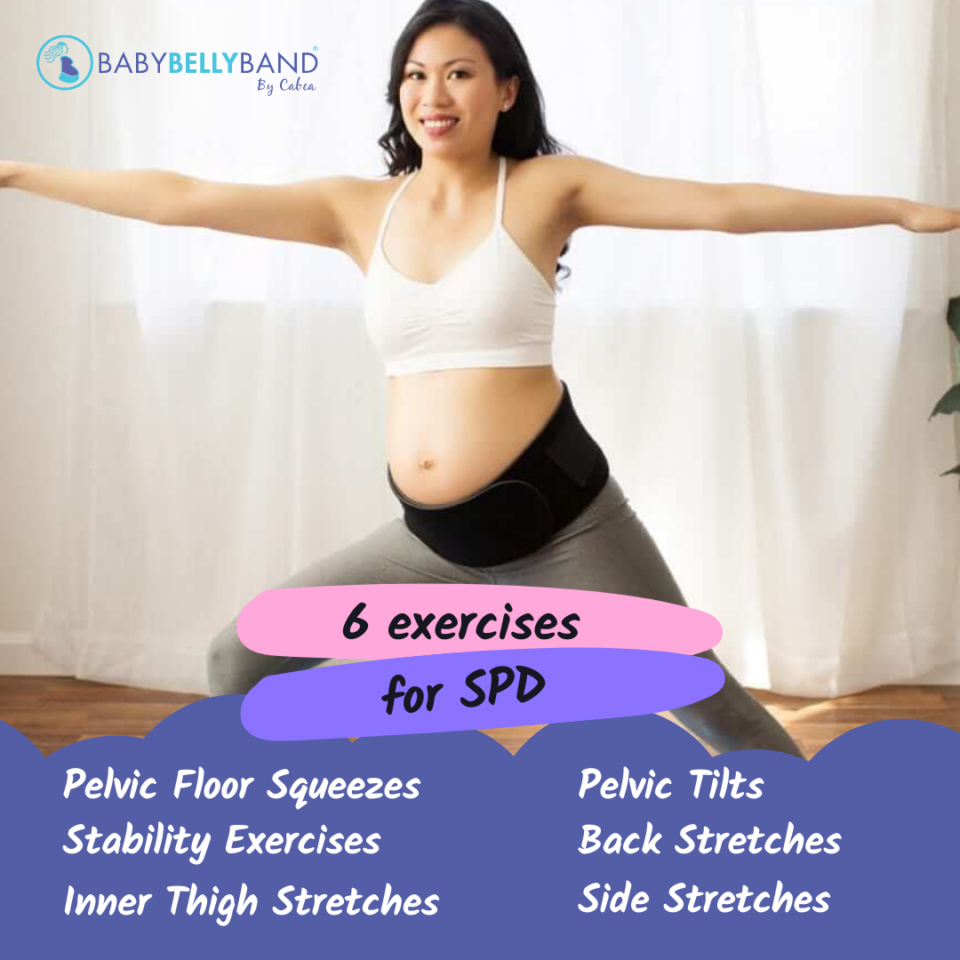Best Exercises for Symphysis Pubis Dysfunction

The content below was summarized from the following WebMD article.
Pregnancy can affect many parts of the body, but it most frequently affects the pelvis. Your pelvis changes shape as your pregnancy progresses. Sometimes the joints of your pelvis are stiff or don’t move at the same time, and this can cause pelvic pain. This condition is called symphysis pubis dysfunction (SPD) or pregnancy-related pelvic girdle pain.
If your pelvic joints are moving unevenly, it can make your pelvis less stable. As a result, moving, walking, and sitting can all be very painful. However, there are several exercises you can complete that may relieve pain and help your pelvic joints move more evenly.
Safety Considerations
Symphysis pubis disorder is not harmful, but it is painful. Exercises to relieve SPD are intended to reduce this pain. If any exercise seems to cause you more pain, stop immediately.
If your pain lasts or seems to get worse, talk to your obstetrician. They can help you find additional treatments to relieve the pain from SPD and help improve your quality of life.
Exercises to Help Symphysis Pubis Dysfunction
Pelvic Floor Squeezes
Working the muscles on the inside of your pelvis can help support your pelvic bones, your internal organs, and your baby.
Step 1: Identify your internal pelvic muscles. Imagine the feeling of holding your urine. The muscles you are squeezing are your pelvic floor muscles.
Step 2: Sit in a comfortable position on a firm chair. Slowly squeeze your pelvic floor muscles up and in. Hold it for ten seconds, then release. Repeat this ten times.
Step 3: Pulse your pelvic muscles up and in as hard as you can, then immediately release. Repeat this ten times.
Do this three to four times a day.
Stability Exercises
Your abdominal muscles are also important for stabilizing your pelvis. This exercise helps gently strengthen these muscles.
Step 1: Find a comfortable position where you can keep your back straight. Place one hand on your stomach just above your pelvis.
Step 2: Breathe in through your nose, then exhale slowly and squeeze your stomach in towards your spine.
Step 3: Hold this squeeze for up to ten seconds, while continuing to breathe normally.
Repeat this up to ten times a day.
Inner Thigh Stretches
Stretching your thighs apart can release tense hip muscles and help prepare you for delivery.
Step 1: Sit in a chair with your feet flat on the floor. Walk your feet apart as far as you can while keeping your knees bent at a 90-degree angle.
Step 2: Place your hands on the insides of your thighs and press your knees further apart. You should feel a comfortable stretch.
Step 3: Hold this position up to thirty seconds.
Repeat this three to five times a day.
Pelvic Tilts
This exercise can help you loosen up tight muscles in your back, which can relieve pain in your pelvis.
Step 1: Sit on the edge of a chair with a firm seat.
Step 2: Tilt your pelvis backwards so it feels like you are slumping forward.
Step 3: Tilt your pelvis forwards, arching your lower back.
Step 4: Repeat this back and forth rocking motion ten times.
Repeat this three or four times a day.
Back Stretches
Stretching your back can help your pelvic joints move and relieve pain from pressure on your pelvis.
Step 1: Lean forward onto a table so your back is parallel to the floor. Rest your weight on your elbows and forearms.
Step 2: Slowly lean backward so you feel a stretch in your back and thighs. Hold this position for ten seconds, then return to neutral.
Step 3: Swing your hips from side to side several times.
Repeat this as many times as feels comfortable.
Side Stretches
This stretch can help reduce pressure on either side of your pelvis.
Step 1: Sit in a chair with your feet flat on the floor. Lift one arm straight in the air.
Step 2: Look away from your arm and lean in that direction. Arch the arm that’s in the air over your head and feel a stretch along your side.
Step 3: Hold this position for ten seconds, then repeat this with your other arm.
Repeat the entire stretch three to four times a day.
Read the full article at WebMD.
Visit a Pelvic Floor Physical Therapist near you
